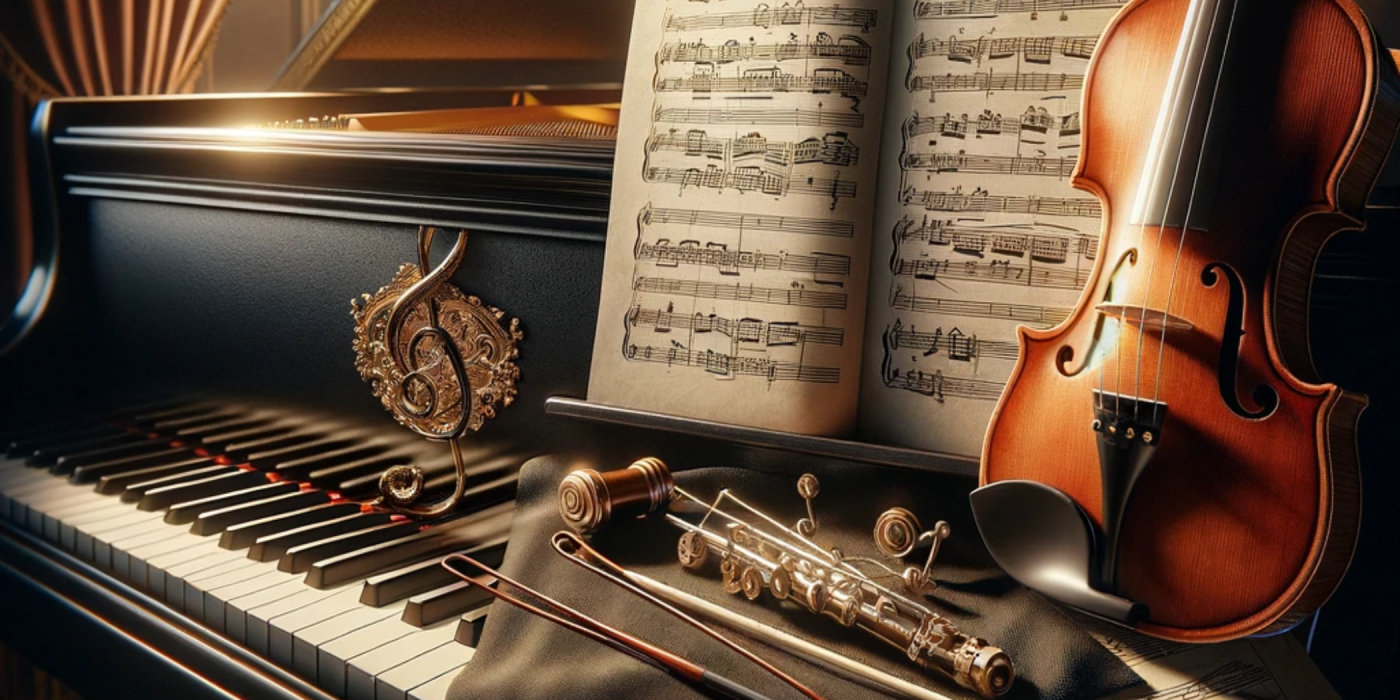Serene Symphony: Exploring 10 Timeless Classical Pieces for Unwavering Tranquillity

In the realm of music, the delicate, timeless compositions of classical masters stand as an unwavering beacon of tranquility and emotional expression. Our day-to-day life, often encompassed by a bustling whirlwind of activities, responsibilities, and unforeseen challenges, silently nudges us toward seeking moments of serenity, reprieves where our soul can quietly linger, unfettered by the external world. Classical music, with its profound, immersive melodies and meticulously crafted harmonic structures, emerges as a sanctuary wherein our spirits find that coveted calmness and momentary escape from the persistent din of daily existence.
The Tranquil Echoes of Classical Music
In the gentle sway of a string ensemble or the soft whispers of a piano melody, classical music enfolds listeners in a gentle, comforting embrace, providing an invitation to explore the landscapes of our inner world. The therapeutic effects of these timeless compositions have been lauded for generations, offering a respite where the mind can meander through corridors of reflection, nostalgia, and peaceful repose. The psychological and physiological benefits – from reduced stress levels to enhanced emotional well-being – have found recognition and affirmation within scientific, artistic, and philosophical circles alike.
Embarking Upon a Melodic Sojourn
As we prepare to meander through this curated selection of classical pieces, envisage each composition as a chapter of a wider narrative; a story interwoven with harmony, historical resonance, and a quiet, yet profound, emotional depth. Allow this exploration to be more than merely an auditory experience – let it become a journey through which your soul finds peace, respite, and a gentle echo of timeless serenity amidst the often tumultuous symphony of everyday life. May this exploration serve as a key, unlocking doorways to tranquil realms, as we delve into the ethereal world of classical compositions renowned for their soothing, restorative aura.
The Allure of Classical Music
Timeless Harmonies and Emotional Tapestry
The mystical realm of classical music has, for centuries, enraptured listeners in a delicate web of emotive, serene, and sometimes, exhilarating tapestries of sound. With each stroke of a bow, press of a piano key, or blow of a wind instrument, it casts an enchanting spell, transporting us to realms where our emotional and spiritual selves are given free rein to explore, express, and exhale. Be it the melancholic, gentle drapes of a Chopin nocturne or the resplendent, poignant crescendos of a Beethoven symphony, classical music carves out spaces of splendid isolation, where the soul, unfettered by the tangible, dances freely amid notes and harmonies.
The Scientific Symphony: Well-being in Every Note
A Melody of Mental Calm
Delving into the domain of neuroscience, numerous studies have alluded to the tranquil potency hidden within classical compositions. The delicately interwoven melodies and structured harmonies tend to initiate a physiological response, reducing heart rate, lowering cortisol levels, and easing the mind into a state of relaxed alertness. This isn’t merely anecdotal; the calming impact of classical music finds roots in its ability to regulate stress, enhance cognitive function, and even ameliorate sleep quality.
Physical Resonance
Furthermore, the symbiosis of physical well-being and classical music unfolds like a gentle waltz between biological rhythm and tuneful stimulus. The serene waves of sound permeate our physical being, massaging away tension and guiding the body into a state of relaxed poise. Every note, infused with the quietude and gentle embrace of calm, seeks to weave through our corporeal self, a tapestry that not only visually delights but also physically soothes, underscoring our timeless romance with the gentle caress of classical music.
Pieces for Relaxation: A Guided Journey
In the majestic realm of classical music, where each note is caressed by emotion and every melody tells a tale, we find an enchanting sanctuary that beckons our spirits to wander through passages of tranquility and gentle reflection. This musical journey, drenched in rich harmonies and timeless compositions, provides a soul-soothing escape, facilitating a much-needed pause amidst our bustling lives.
A Prelude to Serenity
Classical pieces, often imbued with the profound emotional experiences of their composers, hold the profound capability to navigate through the intricate tapestry of our emotions, guiding us towards a state of peaceful contemplation. The gentle cadences, the tender melodies, and the eloquent expressiveness of these pieces entwine to create an ambience that invites calmness to permeate through our being.
An Embrace of Tranquility
As we embark upon this curated journey through ten meticulously chosen classical pieces, allow each note to lightly touch upon your senses, coaxing your mind to gently unfurl its usual rigidity and bask in the delicate serenity offered by these timeless melodies. Permit the music to cradle your spirit softly, extending an invitation to explore realms of tranquility and reflective calm, often obscured by the persistent demands of our daily existence.
In the forthcoming exploration, we invite you to gently close your eyes, lend your ears to these exquisite compositions, and allow your soul to meander through the ethereal landscapes painted by the gentle hands of classical maestros. Let us wander, hand in hand, through pathways illuminated by the gentle glow of harmonic serenity, and find, within these timeless pieces, a respite that whispers the tender notes of relaxation and gentle repose.
Ludwig van Beethoven: 'Moonlight Sonata'
Surrendering to the Serenity
Embarking upon our journey through timeless musical landscapes, we find ourselves enveloped by the soft, melancholic tones of Beethoven's 'Moonlight Sonata.' A piece that, despite its creator’s turbulent emotional state, evokes a deep, serene contemplation within its listeners. Woven into its tender melodies is a gentle invitation to reflection, offering a consoling arm around the shoulders of our consciousness.
History Whispers through the Notes
As we allow the music to cascade over us, it's fascinating to explore the historical tapestry from which it emerges. Beethoven’s auditory gift to the world was created amidst a tumultuous period in his life, a time when his hearing began its tragic decline. The 'Moonlight Sonata' thus stands as a paradox, a tranquil sanctuary born from emotional chaos, inviting its listeners into a serene realm far removed from earthly troubles.
The Timeless Embrace of Melancholy
Such is the potent tranquility of this piece that it has found itself whispering through the halls of various cultural moments throughout history, providing solace in times of collective sorrow and personal introspection. Beethoven, through the delicate caresses of his composition, speaks a universal language, reassuring us with every gentle note that tranquility and peace can bloom from even the most troubled of circumstances.
The 'Moonlight Sonata' thus becomes more than merely a composition; it is a timeless embrace, a quiet reminder of the peaceful sanctuary available to us in moments of quiet musical reflection. Through its melancholic yet comforting melodies, it offers a gentle hand, leading us tenderly towards a serene, contemplative space within which our minds can find a moment’s peace.
Claude Debussy: 'Clair de Lune'
Gentle Caresses of Moonlight
When one surrenders to the tranquil embrace of Debussy's 'Clair de Lune', there’s an ethereal, almost celestial tranquility that envelops the soul, intertwining with our inner serenity and guiding us gently into a state of peaceful contemplation. The piece, which translates to 'Light of the Moon', carries listeners on a delicate journey through its melodic waves, instilling a gentle caress upon the spirit akin to the soft, embracing glow of moonlight. Debussy’s meticulous composition, with its languid, flowing piano melodies, conjures images of a serene nocturnal landscape, enveloping everything under its quietude and providing a sublime, gentle escape from the chaotic whispers of the everyday world.
A Timeless Soothing Resonance
Legacy and Applications
The poignant allure and comforting embrace of 'Clair de Lune' have not only stood the test of time but have found themselves seamlessly weaving through various facets of modernity. Its calming properties have been harnessed in numerous contexts, from therapeutic environments to media soundscapes, providing a backdrop that encourages mental and emotional unwinding. Filmmakers, therapists, and even businesses have utilised the piece as a sonic pathway to relaxation and introspection, reflecting its universal appeal and perpetually rejuvenating tranquillity. As we allow ourselves to be enveloped by the gentle cradle of its harmonies, we’re reminded of the timeless capacity of music to transcend, soothe, and harmoniously align our emotional and mental states. 'Clair de Lune', in its sublime delicacy, thus remains an enduring classic in our collective journey towards serenity and calm.
Johann Pachelbel: 'Canon in D'
Unveiling a Tapestry of Tranquility
Johann Pachelbel's 'Canon in D' stands as an emblem of peaceful introspection amidst the larger realm of classical music. Originating from the Baroque period, its gentle melodies weave a lush tapestry of tranquility and effortless grace that has, over centuries, captured the hearts of listeners across the globe. This piece, often lauded for its harmonious progression and cyclical, hypnotic charm, envelops the listener in a serene embrace, offering a gentle escape into a realm of peaceful reflection.
Timeless Appeal and Modern-Day Resonance
A Soundtrack to Calm
'Canon in D', with its ubiquitous presence, permeates many facets of modern culture, subtly embedding its calming essence within various contexts. Its sonorous melodies and delicate harmonic caresses have found a space within the realms of meditation and relaxation, offering an auditory sanctuary that facilitates mental unwinding and spiritual tranquility. Furthermore, its presence in contemporary media – spanning films, commercials, and weddings – illuminates its capacity to encapsulate moments of pure, heartfelt emotion and gentle repose.
Musical Alchemy: Melody and Well-being
The weaving of the cascading melodies not only offers a luscious auditory experience but also has been considered by many as a conduit for mental and emotional well-being. Numerous therapists and meditation guides utilise 'Canon in D' as an aural backdrop to meditation sessions, allowing the gentle, predictable rise and fall of its motifs to guide individuals into a state of mindful calmness.
In essence, Pachelbel’s 'Canon in D', through its gentle, sweeping harmonies and timeless appeal, continues to traverse through eras, inviting listeners to pause, breathe, and immerse themselves within its enduring, tranquil embrace.
Erik Satie: 'Gymnopédie No.1'
A Gentle Wander into Serenity
Upon pressing the play button, one is instantly enveloped by the delicate, flowing melodies of Erik Satie's 'Gymnopédie No.1'. The piece, an epitome of gentle simplicity, stands out not merely as a classical composition but as a timeless journey into a realm where every note seems to suspend the listener between moments of serenity. The tranquil piano notes, each one seemingly a gentle tap on the surface of a tranquil pond, convey an unspoken narrative, awash with an understated yet profoundly deep emotional resonance.
An Oasis of Calm in Composition
Subtle Melodies and Tranquil Moments
Satie, with the masterful touch of a true minimalist, engages listeners, not through complexity or virtuosity, but through the sheer purity of his melodies. 'Gymnopédie No.1' does not seek to overwhelm; rather, it gently whispers to the soul, providing a soft, melodic backdrop against which one’s thoughts can effortlessly drift. His approach to composition encourages a profound, yet accessible connection, allowing listeners of all backgrounds to find solace within the gentle embrace of the notes.
Unveiling Layers of Emotional Depth
Despite the apparent simplicity, or perhaps, because of it, the piece unearths a treasure trove of emotional depth, revealing layers that, much like gentle waves, lap softly against the consciousness, encouraging a state of mindful tranquility. The repetitive, gentle undulation of the melody invites listeners into a state of reflective calm, enabling an escape from the clutches of life’s perpetual motion.
In conclusion, Satie's 'Gymnopédie No.1', with its unassuming grace and soft-spoken emotional eloquence, continues to stand as a testament to the potent tranquility housed within simplicity. A piece where each note seems to breathe with an unhurried ease, inviting listeners to pause, reflect, and simply be, amidst the gentle cascade of its melodic whisper.
Johann Sebastian Bach: 'Air on the G String'
A Gentle Journey through Melodic Tranquillity
Johann Sebastian Bach, a name synonymous with baroque richness and profound emotional depth, offers a sanctuary of serenity through his ethereal composition, 'Air on the G String'. Originating from his Orchestral Suite No. 3 in D Major, this piece, often regarded as an epitome of tranquillity, invites listeners to meander through its gentle, caressing melodic lines, cradling their spirit in a peaceful embrace.
The Essence of Peace
Delicate Allure of the Strings
The composition is meticulously crafted, where each note seems to float, suspending time and enveloping the listener in a peaceful cocoon. The string arrangement, delicate yet profound, gently whispers to the contemplative soul, ushering in a quietude that is both poignant and uplifting. Bach’s genius allows the instrument to sing, the violin tenderly conversing with the listener, unravelling a tapestry woven with threads of peace and introspection.
An Immersive Experience
While arguably simple in its arrangement, 'Air on the G String' fosters an immersive experience, where each bowing motion seems to breathe, intertwining with the listener’s senses and soul, casting a gentle spell of tranquillity. Its melodious tendrils wrap around our consciousness, quietly dissolving the cacophony of the external world, offering a gentle refuge within its harmonic embrace.
The Timeless Refuge of Bach’s Music
Engaging with 'Air on the G String' provides not merely a listening experience but an invitation to traverse through realms of peace, momentarily stepping away from the tangible world into a space where serenity reigns supreme. The piece does not command; it subtly draws the listener into a gentle cascade of harmonies, providing a backdrop where peaceful moments are not only envisioned but profoundly felt, weaving a timeless escape into the soulful sanctuary of classical music.
Ludovico Einaudi: 'Divenire'
Mesmerising Melodies in the Contemporary Classical World
In the rich tapestry of contemporary classical music, Ludovico Einaudi emerges as a weaver of exquisite, emotion-infused melodies. His piece 'Divenire' ascends as a poignant example, gifting listeners a journey into expansive, emotional landscapes through its stirring harmonies and delicate piano intonations. Einaudi’s craft reflects a nuanced understanding of musical narratives, where every note appears to whisper timeless tales and every chord invokes profound, subtle emotions.
'Divenire', Italian for 'to become', serenades listeners with a gentle yet insistent progression of chords, encapsulating a transformative musical journey. The piece doesn’t merely present itself as a background melody but invites the listener to partake in an experiential voyage. Its gentle undulations and spirited ascents create a musical tapestry that is, in essence, a balm for the spirit, softening the edges of our often hectic realities with its smooth, flowing melodies.
A Tranquil Space Through 'Divenire'
The Therapeutic Layers of Music
Einaudi's creation, whilst certainly capable of standing alone as a splendid auditory experience, has found its place in various modern contexts as a conduit for tranquillity and reflection. Therapists, meditation guides, and wellness practitioners often weave 'Divenire' into sessions, providing a sonic backdrop that gently cradles listeners into states of serene contemplation and mindful awareness. The piece becomes a medium through which the mind is invited to wander, to explore its depths at a languid, unhurried pace, and to ultimately find a resting place amidst its soothing melodies.
The Universal Appeal of Einaudi's Compositions
Within Einaudi's compositions, we find a universality that transcends cultural and social boundaries. 'Divenire' is not merely music; it’s a globally acknowledged space of peace, offering every listener a momentary respite from the cacophonies of their daily lives. Einaudi skilfully transports his audience through dimensions of calm and introspection, affirming the piece’s status as not just a creation of art, but a sanctuary crafted from melody and harmony. In this, 'Divenire' stands, timeless, offering hands of gentle solace to any and all who find themselves enveloped in its calming embrace.
George Frideric Handel: 'Water Music'
Flowing Through Tranquil Melodies
In the ethereal notes of George Frideric Handel's 'Water Music', listeners are gently escorted into a realm where the undulating waves of water entwine with serene musicality, weaving a tapestry that engulfs the soul in tranquil reflections. A suite steeped in the baroque splendour, 'Water Music' cascades through a series of movements, each endowed with its own distinct, yet uniformly calming, character, exploring a spectrum of moods while maintaining a delicately balanced cadence throughout.
The Graceful Ebb and Tide of Notes
The essence of water – perpetually in motion, yet embodying a tranquillity that, paradoxically, offers a grounding solidity – finds itself mirrored in Handel’s deft compositional choices. From the lilting melodies of the woodwinds to the gentle caress of the strings, each note seems to ripple outwards in gentle concentric circles, evoking images of a calm lake kissed by a gentle breeze. The orchestration, though complex in its arrangement, perpetuates a simplicity that allows the listener to sail smoothly upon its gentle waves, lost in contemplation.
Water as a Metaphor for Calm
Water, with its omnipresent metaphorical linkage to emotional depth, reflective stillness, and serene expanses, pairs harmoniously with the relaxing intent behind the piece. Handel’s ‘Water Music’, despite its royal commission and regal premier upon the River Thames, transcends its historical context, morphing into a timeless entity that beckons listeners into a haven of peace. Its melodies whisper tales of gentle river currents, silently reassuring us of the ever-present tranquility available within the realms of classical music.
In navigating through the gentle tides of 'Water Music', one becomes enveloped in a serenity that only timeless music, interwoven with the soothing imageries of nature, can bestow. This piece not only stands as a testament to Handel’s masterful composition skills but also as an eternal sanctuary where weary souls may seek repose.
Pyotr Ilyich Tchaikovsky: 'Swan Lake'
A Melody that Caresses the Soul
'Swan Lake', woven from the delicate threads of Pyotr Ilyich Tchaikovsky’s emotional depth and intrinsic musical brilliance, daintily steps through realms of melancholy, imbibing its harmonies with a gentle power to serenely cradle the listener into a state of reflective calm. The composition, narrating a poignant tale through its ebbs and flows, skillfully intertwines a balletic grace with a tranquil musicality, crafting a peaceful oasis amidst the tumultuous waves of life’s myriad emotions.
Subtle Invitations to Reflective Calm
The thematic substance of 'Swan Lake' not only rests upon the palpable elegance and soft, sorrowful timbres but also in the way it nurtures a safe haven for introspective moments. Tchaikovsky, through each note, conjures an audial environment where serenity blossoms amidst melancholic undertones, offering listeners a sanctum where their thoughts and emotions can quietly dance, unfettered by external chaos. The subtle melancholy, intricately laced through every melody, doesn’t dampen spirits but rather, it gently ushers in a stillness, a placid pool wherein reflections of self and season elegantly glide.
Engaging with the Tranquil Spirit
Navigating through the harmonious passages of 'Swan Lake', we are encouraged, even if momentarily, to allow our spirits to sway with the graceful notes, to allow them to softly permeate our being, inviting us to pause, breathe, and immerse within the tranquil embrace that Tchaikovsky has so exquisitely crafted. Thus, we find not only a piece of music but a timeless vessel that effortlessly transports us to realms where tranquility reigns supreme, and where the soul, albeit gently, is permitted to exhale.
Frédéric Chopin: 'Nocturne in E-Flat Major'
Soothing Nightscapes: An Ode to Tranquillity
Within the gentle, lilting melodies of Chopin’s 'Nocturne in E-Flat Major, Op.9 No.2', there lies a tranquillity that invites the listener into a dreamlike embrace. Frédéric Chopin, a Polish composer of the Romantic era, crafted nocturnes that explored the depth of serene, nocturnal atmospheres. His ability to weave delicate, complex emotions into the simple serenity of a composition allowed him to sculpt a piece that feels like a gentle whisper to the soul, offering solace and a tender, quiet place for reflection.
The Alluring Dance of Notes
An Emotional Tapestry
The 'Nocturne in E-Flat Major' marries a graceful melody with a subtle, yet expressive, depth of emotion, guiding the listener through a gentle journey under a moonlit sky. The piece’s right-hand melody is as delicate as it is emotive, offering an intimate insight into a contemplative tranquillity. Simultaneously, the left hand provides a consistent, flowing accompaniment, enveloping the listener in a gentle ebb and flow of serene musical tides, making it a favourite amongst both classical aficionados and casual listeners alike.
An Invitation to Tranquil Spaces
As we delve deeper into this masterful composition, it's easy to visualise a peaceful night under a blanket of stars, with the melodious tune cradling your thoughts and pacifying the mind. The subtle undulations and expressive nuance of the nocturne seem to encourage a surrender to peacefulness and reflection. A gift that Chopin has granted through his timeless musical creation, the 'Nocturne in E-Flat Major' stands as a haven within music, where one might seek refuge from the bustling noise of the waking world.
Thus, we find in this piece, not just notes and melodies, but a gentle friend who whispers solace into our ears, encouraging a pause, a breath, and a moment to simply be amidst the ethereal beauty conjured by such splendid musical craft.
Wolfgang Amadeus Mozart: 'Piano Concerto No. 21, Andante'
A Symphony of Serenity and Emotional Eloquence
Wolfgang Amadeus Mozart’s ‘Piano Concerto No. 21, Andante’ is an embodiment of grace, an ethereal journey through gentle melodies and serene soundscapes that gracefully sweep listeners into a tranquil reverie. Mozart, with his characteristic mastery over musical narrative, weaves a tapestry where every note seems to glide effortlessly, evoking a celestial, calming atmosphere, guiding minds towards a space of introspective peace.
An Ode to Widespread Acclaim and Emotional Resonance
Enchanting Audiences through Time
Mozart's Andante has charmed audiences globally with its exquisite melodic progressions, emanating a calmness that transcends temporal boundaries. Its timeless resonance has established it as a piece that not only delights classical aficionados but also invites those unfamiliar with the genre into a gentle embrace, providing a soft landing into the world of classical music. Employed in various mediums, from films to meditation sessions, it continues to be a favourite to convey tranquillity and emotional depth.
In the Realm of Relaxation
Delving deeper, the piece has been utilised expansively in contexts promoting relaxation and mental wellness. The slow, steady progression of notes, interwoven with delicate emotive pauses, provides a backdrop against which one’s mind can meander through thoughts at a leisurely pace, or simply bask in the gentle musical caress. In wellness spheres, Mozart’s Andante is often a chosen companion for meditative practices, underscoring moments of reflection with its tender, comforting melodies, and providing a sanctuary of calm amidst life’s unyielding rushes.
The eternal allure of the 'Piano Concerto No. 21, Andante' stands as a testament to Mozart’s incredible capability to encapsulate such serenity within musical notes, crafting a sanctuary where listeners find a timeless retreat into tranquillity.
The Tranquil Legacy of Classical Music
The Timeless Soothe of Classical Notes
The lulling cadence of classical music has, for centuries, caressed the tempestuous waves of human emotions, casting a gentle net of tranquility over turbulent minds and weary souls. The compositions, meticulously crafted, resonate through time, weaving a tapestry that eloquently speaks the universal language of serenity and repose. The geniuses behind the compositions, such as Beethoven, Chopin, and Debussy, orchestrated not merely notes, but melodic narratives that traverse through epochs, retaining their calming potency.
Imprints on Modern-Day Tranquillity
Echoes in Contemporary Media
From the silent, sepia scenes of early cinemas to the vibrant, visual story-telling of today, classical music has gracefully danced across the visual media, swathing tales in a calm, serene ambiance. Pieces like Debussy’s 'Clair de Lune' have gracefully adorned countless scenes, be it in films, series, or commercials, invariably being chosen as a companion to moments of reflection, gentleness, and solace, facilitating a lush, emotional dialogic between the narrative and the audience.
A Sanctuary in Sound Waves
Furthermore, as our society increasingly embraces mindfulness and meditation, the ever-present, unspoken serenity embedded within classical pieces has found a sanctuary in the realm of wellness. The timeless compositions, curated decades or centuries prior, have seamlessly integrated with contemporary practices of mindfulness, yoga, and meditation, ushering practitioners into a realm of peace and introspection through timeless melodies.
The undulating notes, cascading through time, have crafted a legacy wherein classical music stands as a perennial source of tranquility, an auditory balm that ceaselessly nurtures our pursuit of peace and mental wellbeing. This exemplifies how the serene echoes of the past continue to enrich, comfort, and gently cradle our modern-day moments of stillness and reflection.
Conclusion
Reflecting on a Melodic Respite
As our excursion through these delicately crafted, timeless compositions comes to a gentle close, we can't help but linger in the tranquillity left in the wake of such masterful sounds. Each note, harmoniously woven into the next, presents an invitation, coaxing our minds away from the chaotic whirlwind of daily life and into a serene haven where respite and calm prevail. From the iconic, celestial melodies of Beethoven's 'Moonlight Sonata' to the soothing, contemplative caress of Debussy's 'Clair de Lune', we have meandered through a curated selection of classical pieces, each an epitome of tranquillity in its own right, each offering a unique pathway into peaceful introspection.
A Personal Journey Through Sound
The Infinite Tapestry of Classical Music
But the journey does not conclude here; indeed, the vast expanse of classical music offers countless treasures yet to be discovered. It behoves us to further meander through the tranquil realms of sound, to uncover the soothing melodies that resonate with our individual spirits, and to craft our own serene escape amidst the timeless notes of classical compositions. This journey, deeply personal yet universally understood, invites us to explore, to immerse, and to find peace within the gentle embrace of music. May you find solace in the echoes of these timeless pieces and may your spirit find a calming companion in the gentle, undulating waves of classical music’s endless ocean.
Related to this article are the following:
I do hope you have enjoyed this article and hope that you will subscribe to my newsletter so you can get the latest information about all things naturally relaxing.
Stay in touch, join the Naturally Relaxing Newsletter
Newsletter Signup
Post Your Comments
or post as a guest
Be the first to comment.
Latest articles in Music

The Best Music for Meditation: A British Expert's Guide to Deepening Your Practice

The Best Music for Studying: An Expert's Guide to Optimal Concentration & Memory Boost

Melody & Dreams: The Musical Route to a Restful Night

The Healing Power of Music: Combatting Stress & Anxiety in Modern Britain

Relaxation Music: The Scientific Symphony of Serenity






